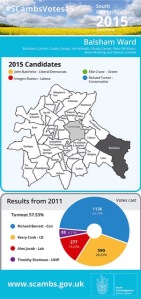This session was led by Geoff Coleman who can be found on Twitter @ColeBagski
- Birmingham City Council (BCC) trialled using WhatsApp during the 2015 General and Local Elections
- people were encouraged to sign-up to receive information throughout the elections
- bought a £30 pay as you go Android phone, loaded WhatsApp and synced it to work desktop PC using WhatsApp Web, no cost apart for this as long as the phone is linked to a wifi network
- used desktop WhatsApp Broadcast lists (up to 256 people per list) which act like an email blind carbon copy list – everyone on the list can see what you’ve sent out but not who else has received it, individuals can also send back messages to the broadcaster and no-one else will see them
- WhatsApp can be a little shaky so less suitable for time-sensitive news
- if you wanted everyone to see all of the messages back and forth you could use the group chat function instead, but this would make everyone’s details available – perhaps best for discrete internal groups with clear parameters
- BCC asked local online influencer to help spread the word as well as using their own channels
- just under 600 people signed up to the service – how to opt out was also made clear and easy- and attracted a younger profile than other social media audiences who weren’t necessarily following the Council’s Twitter or Facebook accounts
- as it was an opt-in service, the majority of interactions were polite and productive, with good inquiries that help shape content, as interactions are not public less trolling or showboating as there’s no external audience
- the BCC team sent out information and updates using text, video and graphics as well as updates from the election count as quickly as possible – hard to keep up on any channel when results are coming in thick and fast though
- after the election users were asked for feedback which was positive overall
- had support from chief executive Mark Rogers who was filmed to get across key messages – videos were short, shot on an iPhone and edited in iMovie
- a few people did try to call or text the WhatsApp phone but were helped to sign up to the service
- using WhatsApp did create more work over the election campaign but it was high quality engagement
- which other services could use WhatsApp and deliver added value to publics? Suggestions included:
- roadworks
- arts and culture updates
- adoption and fostering groups to put people in touch with each other and to share news and advice
- virtual focus groups allowing people to contribute in a group setting but without the dynamics of a face-to-face group where quieter people can be overwhelmed
- community forums and discussions
- groups such as tenants and sheltered housing residents
- first responder groups in an emergency or to potentially ask the public for incoming information
- the application works well for niche campaigns, wouldn’t work as well for time-sensitive news – if you’re interested in X sign up here and we’ll send you Y as and when
- Project WIP at Shropshire County Council has trialled using WhatsApp for residents to contact Councillors
- are there other social messaging apps that could be used? Kik, Snapchat and YikYak were all mentioned but “why would you want to go into that space and would you be welcomed?” was a point made by one delegate


